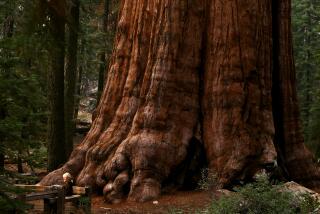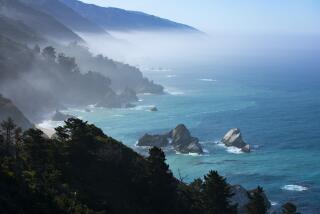State urged to turn over parks to local governments, nonprofits
SACRAMENTO — California’s first attempt to run a park more than a century ago was a disaster. Over a campfire in the backcountry, John Muir himself urged President Theodore Roosevelt to rescue thousands of acres in the Yosemite Valley from the state’s neglect — and it remains a national park to this day.
The state found redemption after that rocky start, and went on to preserve 1.5 million acres of coastline, forests, mountains and historic sites, including some of the nation’s most famous landmarks.
But now, in a stinging assessment, a government oversight agency says that state parks are in such disarray and disrepair that officials should cede control of many of them to cities, counties or private operators.
A report from the nonpartisan Little Hoover Commission released Monday said years of heedless growth had saddled the state with more land than it is equipped to manage, and the lumbering Department of Parks and Recreation has allowed the system to slip into obsolescence.
At some park entrances, credit cards are useless because fees must be paid by slipping cash into hollow metal posts. Budget cuts have stalled more than $1 billion in roadwork, bathroom repairs and other badly needed maintenance. Hundreds of thousands of artifacts are locked away in outdated warehouses rather than on display in museums.
Organizations that have tried to work with the state have repeatedly been dealt with clumsily, exasperating groups that could prove key to parks’ survival, the report said.
Instead of investing and innovating, “California rested on its laurels,” former commission Chairman Daniel Hancock, who oversaw the study, wrote in a letter to Gov. Jerry Brown and top lawmakers. “California allowed its justly renowned park system to fall into disrepair, saw visitor numbers drop and generated concern about the public trust legacy it is leaving to future generations.”
The report adds to the turmoil surrounding the park system, which has become notorious for financial problems. Last year, officials found $54 million in department accounts at the same time the state was threatening to close dozens of parks. Since then, the department has suffered a series of troubling disclosures about shoddy accounting and outdated management practices.
The head of the board charged with overseeing the park system plans to pursue the Little Hoover Commission’s recommendation for a sweeping examination of how the department operates.
“This is a moment of critical transition for the department,” said Caryl Hart, chairwoman of the State Park and Recreation Commission.
Anthony Jackson, the former Marine major general who became director of the parks department in November, also supports a review of which parks should remain under state control, said Roy Stearns, a spokesman for the agency.
California’s state parks are second only to Alaska’s in total acreage. Nearly 68 million people visited a state park between July 2011 and July 2012.
Without changes, parks could close and communities would lose an important source of tourism. Creative thinking is needed, the report said, but the system is stifled by management dominated by rangers who are schooled in law enforcement but not entrepreneurship.
“We can’t do it the way we’ve been doing it,” said Stuart Drown, executive director of the Little Hoover Commission. “The existing model doesn’t work to support the number of parks that we have.”
Evidence of that came last year as officials prepared to close 70 of the state’s 280 parks because of budget cuts. Individual donors, nonprofits and local governments stepped forward to prevent the threatened closures.
Because state funding has declined over the years, the Little Hoover Commission says those agreements are key to the park system’s future. The goal, Drown said, is to ensure that visitors don’t notice a difference in a park even if the organization running it changes. For example, some parks could pool more resources with adjacent sites run by counties or the federal government.
A former parks director, Donald Murphy, told the commission that nearly half of the state’s parks might be better off in the hands of local governments or other organizations. Hearst Castle, the hilltop estate built by newspaper publisher William Randolph Hearst, is one property the state should consider giving up, the report said, because revenue can’t keep pace with maintenance costs.
The commission, however, does not specify how California would find enough money to keep all its parks open and finance improvements. It may not always be possible for local governments to assume the cost, said Chris McKenzie, executive director of the League of California Cities.
“Cities don’t print money, just like the state doesn’t print money,” he said. “The cities may have other priorities they think are more important, like putting cops on the street.”
Plus, the state’s relationship with various partners has been strained. Carolyn Schoff, president of a network of nonprofits that partner with the parks system, says state officials have vetoed ideas that could draw more revenue. Efforts to hold weddings or quinceañeras at Pio Pico State Historic Park in Whittier — the former home of California’s last Mexican governor, and a site Schoff has helped save from closure — were rebuffed.
“Our hands have been tied,” she said. “It’s kind of a Catch-22. People are willing to come in and help in different ways, but they’re not able to.”
Stearns, the department spokesman, said Jackson has been traveling the state to court parks supporters.
“He believes that trust is rebuilt daily and he is working to meet with all to gain information to strengthen the system,” he said.
Jackson also supports shifting more authority from uniformed rangers to civilians, which he hopes “will bring more creative ideas” to the table, Stearns said.
Right now, the parks system is in the midst of a two-year moratorium on park closures, financed in part with the hidden money discovered last year. Elizabeth Goldstein, president of the California State Parks Foundation, described it as a window of opportunity.
“It’s extremely important to take advantage of the moment,” she said.
More to Read
Start your day right
Sign up for Essential California for news, features and recommendations from the L.A. Times and beyond in your inbox six days a week.
You may occasionally receive promotional content from the Los Angeles Times.







